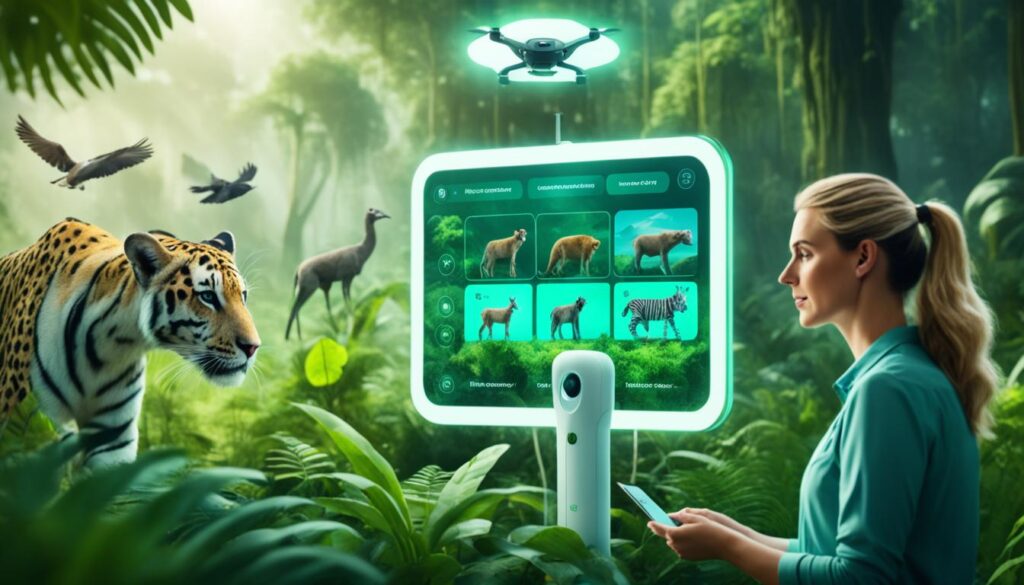What if technology could help us talk to animals? Imagine if we could understand and chat with other species. This is a big dream, and AI is leading the way to make it real. Soon, we might talk to animals like in science fiction.
Scientists use AI to understand animal languages. They want to know what animals say and do. This is not just about us; it’s about connecting with the world around us. AI could change how we talk to animals, helping us understand nature better.
AI is already helping animals in many ways. It’s used in conservation and makes animals’ lives better. We’re exploring new ideas, and AI could change how we talk to animals. This is exciting and could lead to new discoveries.
Recently, scientists have made big steps. They use AI to understand animal sounds and behaviors. Now, they’re working on translating animal languages. This could help us learn more about animals and work together better.

Key Takeaways
- Innovations in AI are leading to new realms of interspecies communication, potentially allowing us to talk with animals.
- Understanding animal languages through AI could revolutionize conservation efforts and alter our perception of wildlife.
- Diverse species are being studied using AI with the aim to translate vocalizations and behaviors into something we can comprehend.
- Real-world applications, such as the Merlin app, demonstrate the feasible identification of animal calls using AI.
- Discoveries in animal communication are contributing to a variety of fields, including neuroscience and biodiversity monitoring.
- New studies challenge traditional notions about animal intelligence and the capability for meaningful communication across species.
The Quest to Understand Animal Language through AI
We are exploring how AI and interspecies communication can connect humans and animals. Using artificial intelligence, we aim to understand animal languages. This is a big scientific goal that helps us learn about our planet’s creatures.
The Innovative Use of Artificial Intelligence in Deciphering Animal Communication
AI has made big steps in understanding animal languages with machine learning. Projects like the Earth Species Project and CETI use smart algorithms and lots of sounds. They try to figure out how animals talk to each other, like sperm whales and New Caledonian Crows.
Exploring Interspecies Communication with AI Technology
Digital bioacoustics shows how AI helps us understand animals better. Researchers use small digital recorders and AI to study animal sounds. For example, Yossi Yovel and his team at Tel Aviv University used AI to understand Egyptian fruit bats’ language.

AI doesn’t just watch and listen. Tim Landgraf from Freie Universität Berlin made a robot, RoboBee, that talks to honeybees. This robot shows AI can talk to animals and help them find food. It shows how animal language translation AI can change how we see the world.
Using AI to translate animal language is full of promise and challenges. We could soon understand animals better, which helps conservation, animal welfare, and our view of life on Earth.
Challenges and Breakthroughs in Animal Communication Technology AI
Exploring AI and animals has been a mix of big challenges and big wins. Trying to use AI to talk to animals is hard because animals make many different sounds and behave in many ways.
The Earth Species Project (ESP) is working hard to understand animal languages. They’ve made big strides with birds, dolphins, and elephants. ESP uses smart tech to learn and predict how animals talk to each other. They can even tell apart different sperm whales by their sounds.
But, making AI talk to animals isn’t easy. There are big questions about protecting animal data and their rights. We also worry about how this tech could be used wrongly.
Still, if we can figure out how animals talk, it could change a lot. It could help protect animals and give them a say in their homes. This could affect the environment, society, and tech.
| Species | Communication Type | AI in Practice |
|---|---|---|
| Sperm Whales | Codas | 99% recognition accuracy |
| Cats | Vocalizations | Decoding sophistication levels |
| Rabbits | Body Language | Potential AI-driven emotion recognition |
In short, making AI talk to animals is tough but we’ve made some big steps. These steps could lead to a future where we understand animals better. Using AI to get what animals are saying could change how we care for animals and connect with nature. As we keep improving AI for animals, we’re working towards living in harmony with all kinds of animals.
Real-world Implications of AI for Animal-Human Communication
AI is changing how we talk to animals and understand them. This is a big step in tech and helps us care for the environment and animals. It’s making us better at talking to animals and understanding them.
How AI-Driven Animal Translation Affects Conservation Efforts
AI is changing how we save animals and protect nature. It helps us understand animal sounds and behaviors. This is key for saving different animals and keeping their homes safe.
The Earth Species Project uses AI to understand animal talks. This helps protect animals in danger. AI also helps keep their homes safe and makes sure they can live there.
The Impact of AI Communication on Animal Welfare and Research
AI is helping animals in labs and farms too. It lets us see how animals feel without them telling us. This means we can make their lives better.
Groups like the Cambridge Centre for Animal Rights Law are looking at how AI can help animals. They want to make laws that protect animals more.

| Feature | Impact |
|---|---|
| AI in Bioacoustics Research | Enhanced understanding and monitoring of wildlife populations |
| AI for Emotional State Analysis in Animals | Improvements in animal welfare and research ethics |
| AI in Biodiversity Conservation | Effective strategies for habitat preservation and species survival |
Using AI to talk to animals is changing how we save nature and treat animals. It helps us understand animals better. And it makes sure we interact with nature in a good way. This is starting a new chapter in saving animals and treating them right.
Case Studies: Talking to Animals AI Technology in Action
We are working hard to talk to animals better. Projects like Project CETI are key. They focus on cetacean communication AI, especially with sperm whales. The project uses three underwater microphones to listen to these big sea creatures. It aims to understand their complex sounds.
Deciphering Cetacean Languages: The Case of Sperm Whales
Researchers use AI to study sperm whales’ clicks. The AI can understand the clicks’ frequency and timing. This shows that sperm whales have a complex language. It helps them talk to each other and work together.
New Caledonian Crows and the Insight on Dialects in Avians
New Caledonian crows are also being studied. They are smart birds that make tools. The research shows they have different ways of talking. They even share their knowledge with others, which affects their culture and tools.
| Species | Technology Used | Primary Discoveries |
|---|---|---|
| Sperm Whales | Underwater AI Listening Posts | Structured language patterns facilitating complex social interactions |
| New Caledonian Crows | AI Sound Analysis | Evidence of regional dialects influencing tool-making culture |
AI technology is changing how we see animals. Projects like these show how smart animals are. They help us understand animals better and appreciate their intelligence and social skills.
AI and Interspecies Communication: What the Future Holds
Looking ahead, the future of AI and interspecies communication looks very exciting. AI is changing how we talk to animals. This could make us understand and connect with them better. We can look forward to big changes in the next few years.
The Earth Species Project (ESP) is leading the way. It started in 2017 with help from big names like Reid Hoffman from LinkedIn. ESP is working hard to help humans and animals talk to each other better.
ESP made a big step with BEANS, a tool to check how well AI understands animal sounds. They also created AVES, a model that helps us understand animal voices. This could be a big step in talking to animals.
ESP is also working on AI that can make new animal sounds and figure out how many sounds a species uses. This could mean we might be able to talk to animals soon.
In the future, AI could help animals more in conservation and welfare. For example, it could tell us when animals are happy or sad. This could make places better for animals.
AI is also helping us understand sperm whales better. This could give us new insights into these smart animals. It could change how we study animals and nature.
AI experts, animal experts, and conservationists are working together. They think AI can make us better friends with animals. We could talk to animals in a new way, not just watch them.
How AI could help us talk to animals
Artificial intelligence is changing how we talk to animals. It helps us understand complex signals from different species. This is a big step forward for science and saving endangered animals.
AI helps us find patterns in animal sounds. For example, it can pick up on special sounds animals make. This lets us see how animals really talk to each other.
One project, the Earth Species Project (ESP), is using AI to understand animal sounds. Since 2017, ESP has been working hard. They’re making AI that can pick out animal sounds from lots of noise.
ESP is working with scientists to study endangered animals. They want to know how these animals talk and react to their world. This helps us make better plans to save them.
But using AI to study animals also raises big questions. We need to make sure it’s used right and not for bad things like poaching. Still, AI could be a big help in understanding and helping animals.
In the end, AI could change how we talk to animals. It could lead to big discoveries in how we save and understand animals. This could make our connection with animals stronger.
Conclusion
AI is changing how we talk to animals. It’s not just a new idea, but it’s getting better fast. We can now understand animal sounds and behaviors with advanced AI like machine learning.
AI helps us tell different animal sounds apart. It even helps us understand what animals mean when they move in special ways. This is making us closer to talking to animals.
AI is now translating animal sounds and actions in real time. This is a big step for saving endangered animals. It helps us understand what they need quickly.
AI is also changing how we see animals. We’re learning they have feelings, friends, and their own languages. This makes us see animals more like us.
But, there are still big challenges ahead, as Yossi Yovel and Oded Rechavi pointed out. We might not fully get animals’ feelings or needs yet. But, we’re working hard to improve.
This work is changing how we save animals and understand them better. It’s making us more caring towards all living things. We’re learning to listen and talk to animals in new ways.
FAQ
How could AI help us talk to animals?
AI can help us talk to animals by using special algorithms. These algorithms look at animal sounds and behaviors. Projects like CETI and the Earth Species Project are working on this.
What role does AI have in deciphering animal communication?
AI is key in understanding animal talk. It uses algorithms to find patterns in animal sounds and actions. This helps us figure out what animals are saying.
How is AI applied in exploring interspecies communication?
AI helps explore how different species talk to each other. It can pick out animal sounds in the noise. This lets us see how animals might talk to each other and to us.
What are some challenges faced in using AI to communicate with animals?
There are big challenges like understanding animal talk and getting lots of data. It’s hard to know the context of animal sounds and behaviors. Making models that work in real life is also tough.
How does AI-driven animal translation benefit conservation efforts?
AI helps conservation by understanding endangered species better. It translates animal sounds to give us insights into their lives. This helps us know how to protect them.
What impact does AI communication have on animal welfare and research?
AI improves animal welfare and research by understanding animal needs better. This leads to better living conditions and ethical research. It helps animals in the wild and in our care.
Can you give examples of AI technology in action interpreting animal languages?
Yes, Project CETI is using AI to understand sperm whales. Researchers are also studying New Caledonian Crows with AI. They’re looking into how birds might have their own languages and talk about complex ideas.
What does the future of AI and interspecies communication look like?
The future looks bright with AI helping us understand animals better. We might get devices that translate animal languages in real time. This could lead to deeper connections with animals.
What benefits does AI offer in improving our understanding of animal communication?
AI helps us track and protect animals, improve how we interact with them, and understand their feelings and thoughts. It could change how we see the world and connect with nature.
How might AI transform our connection with the natural world?
AI could change how we see the world by letting us understand other species. It breaks down language barriers. This could make us value all life more and live in harmony with nature.

